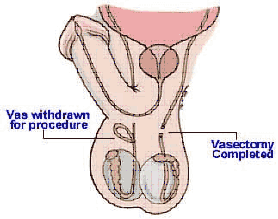vasectomy
WHAT IS A VASECTOMY?
A vasectomy makes a man sterile by obstructing the flow of sperm through the vas deferens (small tubes that drain from the testicles). Subtle variations in technique exist. A “no-scalpel” technique is used to puncture the scrotum rather than using a scalpel to make an incision. Wrestling A small portion of the vas deferens is removed and small, permanent, metal clips are placed on the ends of the vas deferens to occlude them. The ends are burned, tucked back into the scrotum, and the scrotum is closed using an absorbable suture (7-10 days). The procedure is typically performed in the office using a local anesthesia. Some men are very anxious and, in that case, sedation by an anesthesiologist at our surgery center may be required. (Please check with your insurance carrier if you would like sedation to make sure you qualify.)
variations in technique exist. A “no-scalpel” technique is used to puncture the scrotum rather than using a scalpel to make an incision. Wrestling A small portion of the vas deferens is removed and small, permanent, metal clips are placed on the ends of the vas deferens to occlude them. The ends are burned, tucked back into the scrotum, and the scrotum is closed using an absorbable suture (7-10 days). The procedure is typically performed in the office using a local anesthesia. Some men are very anxious and, in that case, sedation by an anesthesiologist at our surgery center may be required. (Please check with your insurance carrier if you would like sedation to make sure you qualify.)
After a vasectomy it takes about 3 months to completely clear your ejaculation of sperm. You will be instructed in how to bring samples in to our office to prove that there is no sperm in your semen. TWO samples devoid of sperm are required (some men have to leave multiple samples to achieve the necessary two, consecutive, sperm-free semen samples) to clear you for unprotected sex. You must continue to use other forms of contraception until you prove that your semen is free of sperm.
SCHEDULING A VASECTOMY
Scheduling a vasectomy is easy. It will consist of a brief office visit with a surgeon to discuss the risks of the procedure and so the surgeon can insure that a patient is a good candidate for a vasectomy by reviewing medical history and doing a brief physical examination. Once the patient is medically cleared and written consent for the procedure obtained, another appointment is made for the actual procedure.
CONCERNS SURROUNDING A VASECTOMY
Although complications are infrequent, patients need to be aware of the risk associated with the procedure.
Recanalization: This word means spontaneous reconnection of the vas deferens and failure of the vasectomy. This complication is rare. Although it can occur at any time, it most often occurs during the first 6-8 weeks after the procedure. Patients must prove that they are sterile by providing semen samples void of sperm before being medically cleared for unprotected sex.
Infection: Uncommon, and usually mild. Most often it can be treated with antibiotics.
Bleeding: Usually mild, although a large blood clot called a hematoma can develop and typically resolve by itself.
Pain: Pain usually lasts several days and goes away. Some patients have pain that can last months to years.
Sperm Granuloma: This is a scar that sometimes forms where the vas is cut. It is usually the size of a pea, and is rarely tender.
Sperm Antibodies: These antibodies help the body get rid of the sperm. They are not harmful but may make it difficult to achieve pregnancy even if the vasectomy is surgically reversed.
Prostate Cancer: The current medical literature does not support a consistent link between prostate cancer and vasectomy.
PREPARING FOR A VASECTOMY
Seven days before the procedure stop taking aspirin, ibuprofen (Advil, Motrin), vitamin E, herbal supplements, or any medication that you take to thin the blood. If you are on Warfarin, Coumadin or Plavix, call you physician regarding these medications.
There are few requirements the day of the procedure. Eat normally unless you are being anesthetized. Please shower or wash the scrotum before the procedure to help reduce the risk of infection. Bring supportive underwear or an athletic supporter with you to wear home. It is best if someone drives you home, it is mandatory someone drive you home if you are receiving anesthesia.
AFTER YOUR VASECTOMY
Go home. Relax. Rest in bed or on the couch for a full 24 hours. Place an ice pack on the scrotum to minimize swelling.
You may shower after 24 hours.
Do not lift anything over 10 pounds for seven days. After that, use your judgment according to how you feel. A good rule of thumb: if you have to ask if you can, you probably shouldn’t. Resume normal activity slowly.
Wait at least seven days before resuming sexual activity, preferably two weeks. You may have some discomfort at first. It is normal, and usually resolves quickly.
Call your physician with questions. Issues that require a phone call are: fever above 100.5, bleeding that doesn’t stop for a couple hours after the procedure, progressive scrotal swelling, pus draining from the incision, pain that cannot be controlled with pain medication.
A FINAL REMINDER
You are not sterile until your semen is completely free of sperm. You must take the responsibility to bring samples into our office to prove your vasectomy is a success. If the above guidelines are followed, it should be.
